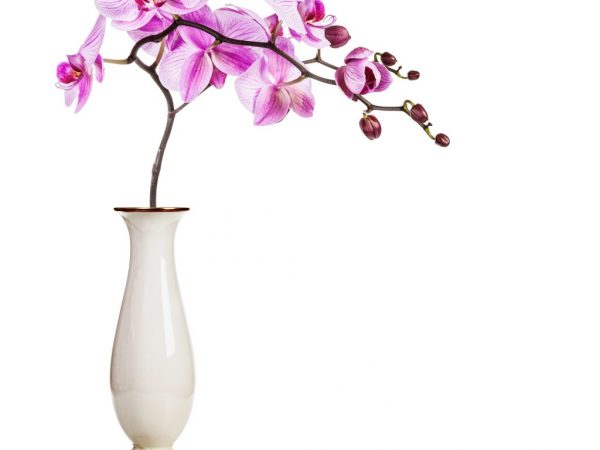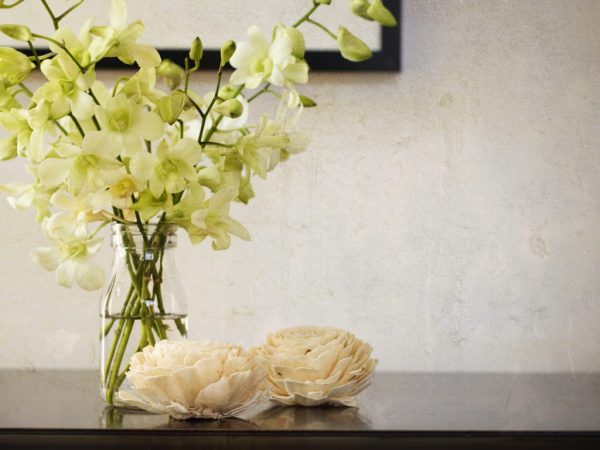Orchid care in vase and flask
Flower lovers are increasingly starting to grow plants in an unusual way. The orchid in a vase and a flask has become especially popular. But not all varieties are suitable for this growing method, and there are some difficulties in caring for a flower.

Orchid care in vase and flask
Growing an orchid in a vase
Growing such a flower in a round vase is becoming more and more popular. The Vanda variety is excellent for this method. This species is distinguished by its large size of flowers and an unusual shape.
So that the uncut orchid in the flask grows well, choose a vessel of a suitable shape. It is better to purchase a vase wide at the bottom and narrowed at the top. When grown in such a container, care should be more thorough due to two factors:
- folded leaves are easily damaged;
- insufficient ventilation provokes the development of fungus.
Benefits of growing an orchid in water
This growing method prevents plant decay and pests. Water circulates constantly. Also, the root system receives the required amount of air.
A flower is grown in this way without transplanting. The plant always receives the optimal amount of nutrients dissolved in water.
Caring for an orchid in a vase involves constant hydration. Wanda is an epiphyte, therefore, in natural conditions, it grows on trees and feeds on condensation or rain moisture.
But the amount of water depends on the air temperature. If the room is cool, water less often, but the humidity will be higher. Therefore, it is best to keep the flower in a cool room. The plant is irrigated only when necessary. If the roots have become brownish, you need to water the flower.
Sometimes an orchid in a vase is sold with dried roots. Reanimating such a plant is not difficult. For this, the flower should be planted in warm water for 10 minutes. The procedure is repeated every day until the roots are fully restored.
If the roots have begun to rot, it is more difficult to bring them back to life. For this you need:
- treat them with Fitosparin;
- then irrigate the flower or make a bath with warm water;
- keep the room temperature at 20 ° C.
If the leaves become lethargic and begin to sag, this indicates weakening of the roots. The plant is removed from the substrate (if any) and replaced with a new, disinfected one, and the plant is suspended in a dark place. This is done so that the energy of growth, which strives upward, is directed towards the growth of roots.
Growing an orchid in a flask

Not all varieties can grow in such conditions.
Plants in a flask (flask) are often brought by tourists from Thailand and Vietnam. In such a container, several seedlings are purchased at once. But when grown in flask, it will begin to bloom in 4-5 years, depending on the variety.
Not all orchid varieties are suitable for growing in a flask, but only vandas, phalaenopsis, dendro-phalaenopsis, oncidiums and cymbidiums. They are resistant hybrids that can bloom every year.
Extracting an orchid
Orchids do not grow for long in a small commercial vessel containing several seedlings at once. In order for the plants to develop, they are removed and placed in separate containers.
You should take care of flowers bought in a flask in stages. Immediately after purchasing, orchids in a transparent glass flask are placed in a warm, humid, draft-free place. This is essential to relieve stress in plants. Then, after 2-3 weeks, when the seedlings begin to grow, they are carefully removed.
Extraction methods:
- Add water to the inside of the flask to make it easier to remove the roots, and wash the seedlings through a small neck. Try not to damage the root system. This is the least traumatic way.
- The container is wrapped with cloth or newsprint and broken. When using this method, there is a risk of damaging the plants.
Flaska orchid care
After removing the seedlings, rinse them under running water and place them on a paper towel. Next, the plants should be sprayed with Fitosporin or Fundazol solution. After half an hour, the seedlings need to be transplanted into flask.
In a transparent glass flask, the seedlings are placed on the prototype of the substrate, so their root hairs are thinner and more fragile. They cannot be preserved without an airtight vessel after extraction, so it is worth building up strong roots.
This is done by placing the seedling in a transparent vessel covered with glass, previously disinfected and steamed moss. This design will retain heat and moisture well.
The condensation on the glass is wiped off, and the container, which serves as a greenhouse, is ventilated. This is done to prevent root decay. Also keep out of direct sunlight. Needs diffused light and humidification from a spray bottle.
To care for orchids in glassware, gradually temper the flowers by opening the container for a longer time every day. In this case, the humidity should be at least 50%.
Further cultivation of orchids
When the orchid seedlings are removed from the glass flask, they are planted in one of the following ways:
- substrate;
- substrateless.
Growing orchid seedlings from a bulb is considered uncomplicated. The flower gradually gets used to growing without soil and substrate in a glass vase or pot. Hanging rack baskets are used, in which the roots will be freely located.
When caring for orchids in flasks, protect them from infections, since the roots of young plants are weakened. A substrate of large pieces of bark, moss and a small amount of earth is fried in advance in the oven or soaked in boiling water. Then let it cool and spray it with Fitosporin solution. Only after this procedure can the seedlings be planted.
Sometimes polystyrene and bark are added to the composition of the substrate, in a ratio of 3: 4. But if the plant is in a room with dry air, perlite or swagnum is added to this mixture.
Growing an orchid in a glass vase does not differ much from growing in a slatted pot. The large throat helps the ventilation of the orchid roots in the flasks. This option helps to grow flowers in a dry environment.
Disease prevention
Once every 1-2 weeks, the flowers are sprayed with special fertilizers. It is also worth pouring a solution of Novosil or Polisilk preparations into a container with a flower. They contain polysaccharides that regulate photosynthesis and stimulate the production of beneficial micronutrients.
Sugar is good for the plant, it effectively supports the root system. The whole plant is treated.
Conclusion
Orchids in glass vases and flasks are a stylish decoration for any interior. This method of growing is not difficult, the plants effectively adapt to different living conditions. It is important to properly water and maintain the required moisture level in the flower. With proper care, the plant will bloom for a long time and please the eye.


